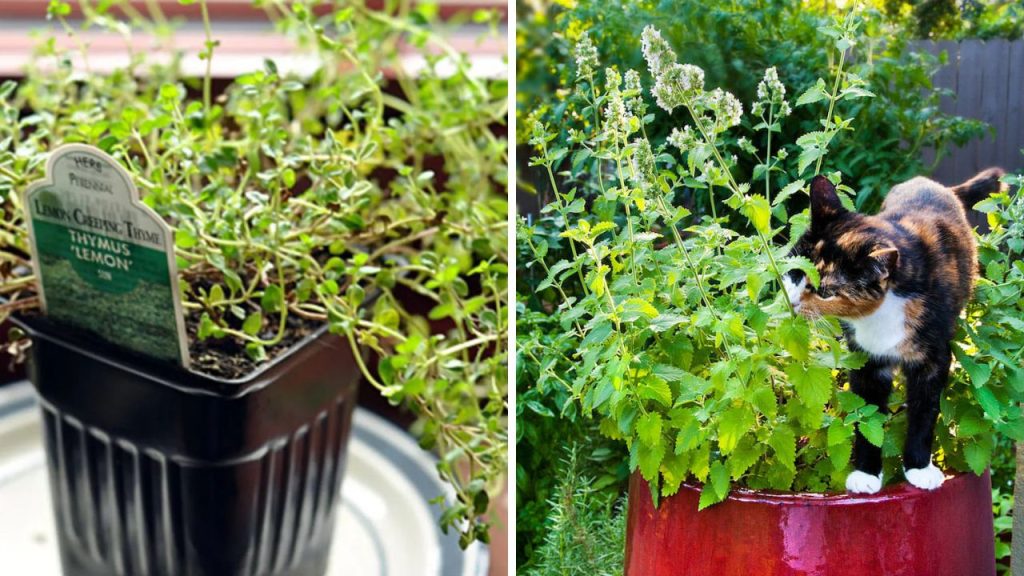When it comes to designing your garden, raised flower beds along a fence are a brilliant way to make the most of your space while adding beauty and character to your outdoor area. Whether you’re looking to create a rustic charm, modern elegance, or something in between, there are countless ways to build raised beds that complement your fence and enhance your garden’s aesthetics. In this article, we will explore 23 ideas that will inspire you to transform your garden into a peaceful haven.
1. Classic Wooden Raised Beds for a Rustic Charm

Wooden raised flower beds are a timeless choice that never goes out of style. They provide a natural, rustic appeal that blends beautifully with fences made from wood or other natural materials. Opt for materials like cedar or redwood, which are not only durable but also resistant to rot, ensuring your raised bed lasts for years.
One of the key advantages of wooden raised beds is their versatility. They can be easily customized to fit the shape and size of your garden space. Whether you choose a simple rectangular design or something more intricate, wooden beds can be built to suit any aesthetic. Additionally, wooden beds can be treated with stains or paints to match or contrast with your fence, adding even more personality to your garden.
The rustic appeal of wooden raised beds works especially well in gardens that feature other natural elements, such as stone paths, gravel, or wood fences. These beds are perfect for growing everything from flowers to vegetables, allowing you to create a functional yet visually appealing garden. Be sure to line the bottom with a landscape fabric to prevent weeds from creeping in and to ensure proper drainage.
2. Tiered Raised Beds for a Modern Look
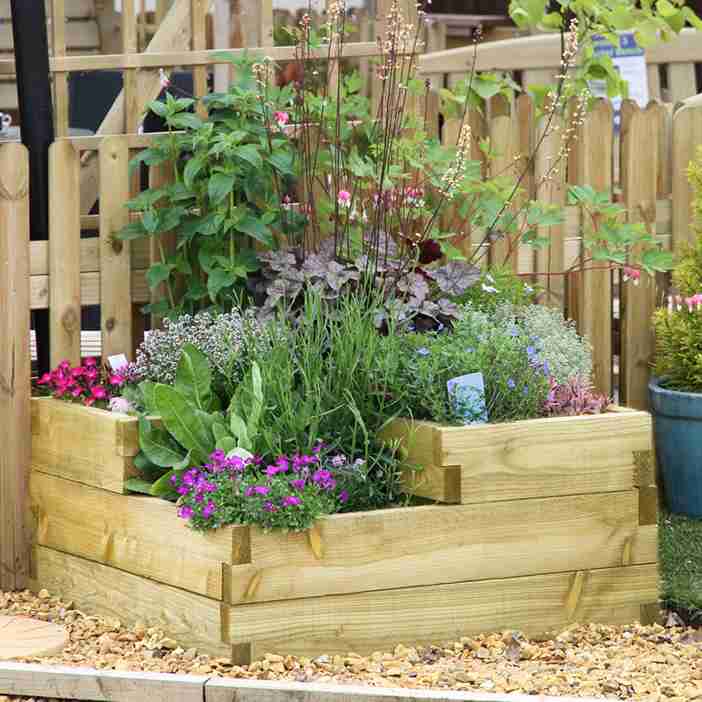
For a more modern, dynamic look, tiered raised flower beds are a fantastic option. This style involves stacking multiple levels of raised beds, creating a cascading effect along your fence. Tiered designs add depth and dimension to your garden, making it appear larger and more intricate. They are ideal for sloped areas or uneven ground, as the tiers can help level the space while providing a visually appealing structure.
Tiered raised beds also offer the opportunity to plant flowers with different growth habits. For example, you can plant shorter flowers in the front tiers and taller ones in the back, creating a stunning visual display. These beds work well with both wooden and metal fences, adding contrast and variety to your garden’s design.
Not only do tiered beds look beautiful, but they’re also highly practical. The different levels provide optimal growing conditions for various plants, allowing you to mix annuals, perennials, and even herbs or vegetables in the same garden. Plus, the elevated design makes it easier to tend to your plants, reducing the strain on your back and knees.
3. Metal Raised Beds for Industrial Elegance

Metal raised beds are an excellent choice for those seeking a modern, industrial look. Galvanized steel or corten steel are popular materials for these beds, as they are highly durable and resistant to weathering. Over time, corten steel develops a beautiful, rusty patina that adds character and warmth to your garden.
The sleek and minimalist design of metal raised beds pairs well with modern fences made from materials like wrought iron or metal. These beds bring a contemporary, urban touch to any garden, making them perfect for city dwellers or those with a more modern aesthetic. They can be arranged in simple rectangular shapes or more intricate patterns, depending on your preferences.
One of the best aspects of metal raised beds is their low maintenance. Unlike wood, which may need to be treated or replaced over time, metal beds require little care beyond occasional cleaning. They are also incredibly durable, making them a great investment for long-term garden success. The clean lines of metal beds create a striking contrast against the organic shapes of plants, highlighting your flowers and making them the center of attention.
4. Repurposed Wooden Crates for a Chic Farmhouse Vibe
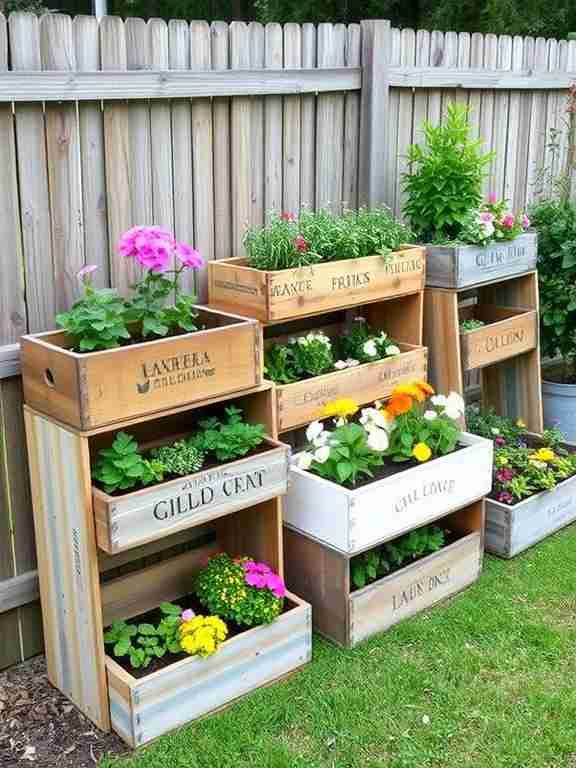
Source
Repurposing old wooden crates for raised flower beds is a fun and eco-friendly way to add charm to your garden. These vintage crates offer a rustic, farmhouse-style appeal and are perfect for creating a unique and personalized garden along your fence. Whether you find old crates at flea markets or repurpose wooden boxes you already have, this idea is both budget-friendly and environmentally conscious.
Wooden crates add a distinct, cozy feel to your garden. Arrange them in a row along your fence or stack them to create a multi-level effect. You can even paint or stain the crates to match your fence or create a colorful contrast. These beds are perfect for small to medium-sized gardens and can be used to grow flowers, herbs, or even small vegetables.
While wooden crates are great for their aesthetic value, they are also highly functional. Their size makes them perfect for growing shallow-rooted plants, like petunias, pansies, or succulents. For larger plants, consider adding extra drainage holes in the bottom of the crates to ensure proper water flow and prevent root rot.
5. Vertical Garden Raised Beds with Fence Support
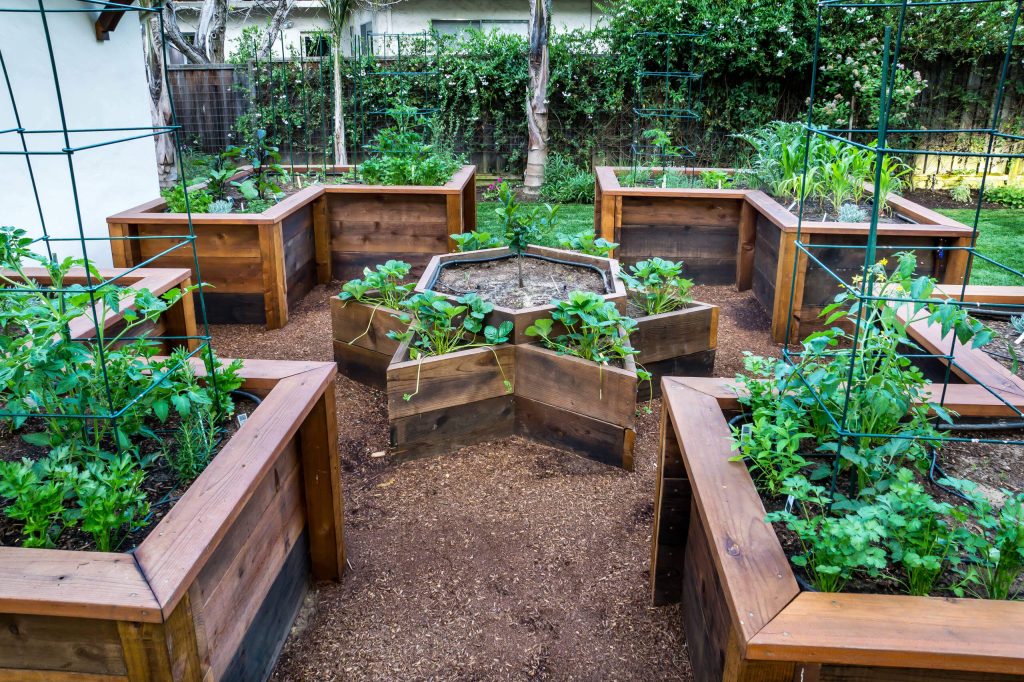
If you’re limited on space, vertical garden raised beds are an ideal solution. These innovative beds take advantage of your fence as a support structure, allowing plants to grow upward rather than outward. Vertical gardens work especially well with climbing plants like ivy, morning glories, and roses, which will flourish as they vine up the fence.
Vertical raised beds are great for maximizing small spaces. By using your fence as a growing surface, you free up valuable garden space for other plants or outdoor activities. These types of gardens can be created with trellises, mesh panels, or even slatted wooden frames that allow plants to grow vertically while being supported along the fence.
This design also adds an element of intrigue and height to your garden, making it appear more expansive than it actually is. It’s an excellent option for creating a living wall of flowers or even a green privacy screen. Vertical gardens can be used to grow a wide variety of plants, including vegetables, herbs, and flowers, providing both beauty and practicality.
6. Raised Flower Beds with Gravel Pathways
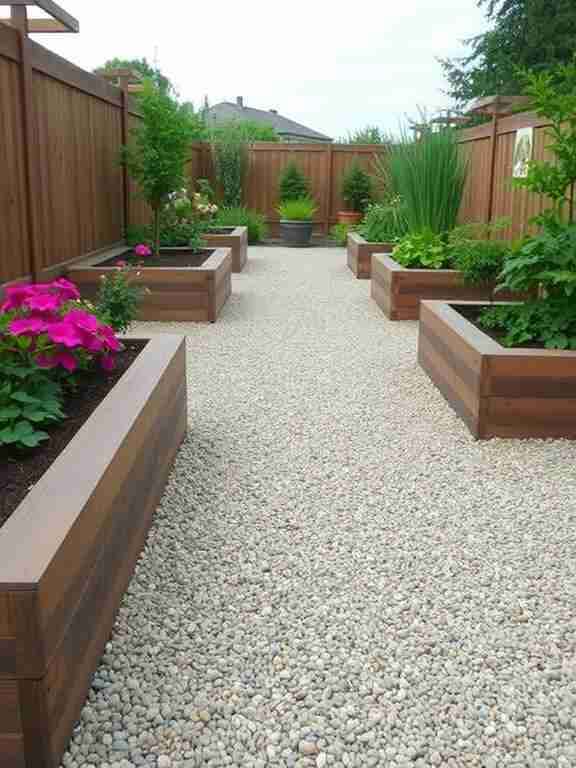
Source
Incorporating gravel pathways between your raised flower beds not only adds visual appeal but also helps with accessibility. Gravel creates a clean, well-defined path that allows you to easily navigate your garden, whether you’re tending to plants or simply enjoying the view. The contrast between the smooth, polished gravel and the lush plants in your raised beds makes for a striking visual experience.
Gravel pathways work well with a variety of raised bed materials, from wood and stone to metal and concrete. The neutral tones of gravel complement almost any garden style, making it easy to blend in with your fence design. Plus, gravel is a low-maintenance material that doesn’t require much upkeep. Simply rake it occasionally to keep it level and tidy.
Not only do gravel pathways help prevent soil compaction and allow for proper drainage, but they also enhance the aesthetic of your garden. The sound of gravel crunching beneath your feet creates a soothing, sensory experience while you explore your outdoor space. This practical design is perfect for creating a garden that’s both beautiful and functional.
7. Herb Garden Raised Beds for Fresh Culinary Touches
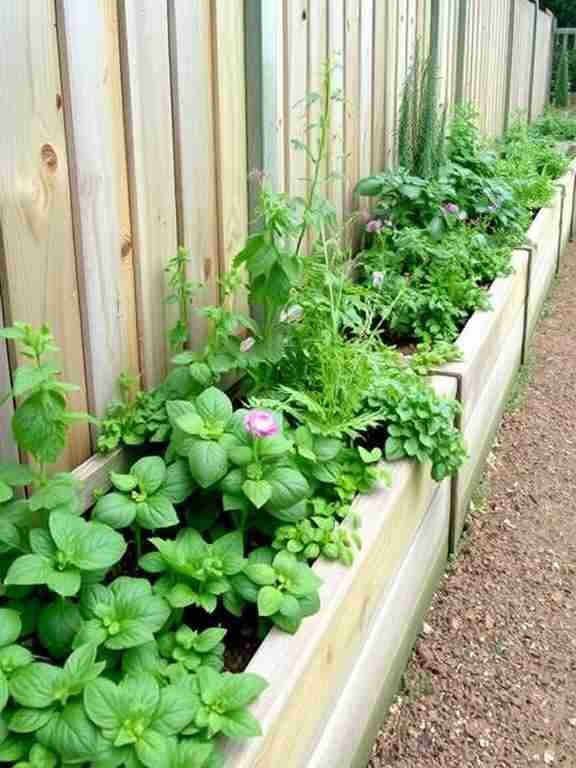
Source
What could be more delightful than having fresh herbs just steps away from your kitchen? Herb garden raised beds along your fence offer both beauty and practicality, allowing you to grow a variety of herbs that you can use in your cooking. Raised beds provide optimal growing conditions, ensuring your herbs thrive while being easily accessible.
Herbs like basil, mint, rosemary, and thyme do exceptionally well in raised beds, as they require well-drained soil and plenty of sunlight. You can design a dedicated herb garden or mix herbs with flowers for added visual interest. Raised beds allow you to create an organized and efficient layout for your herbs, with each plant having the space it needs to flourish.
These beds are perfect for gardeners of all experience levels. They require minimal maintenance once established and provide fresh ingredients for your meals throughout the growing season. Plus, the pleasant fragrance of herbs adds an aromatic touch to your garden, making it a sensory delight.
8. Colorful Raised Beds with Painted Planters

Source
For a lively and cheerful garden, consider painting your raised flower beds in vibrant colors. This design idea is especially great if you want to create a bold statement and inject some personality into your outdoor space. Whether you opt for bright reds, soft pastels, or striking blues, colorful raised beds can instantly transform your garden into a vibrant work of art.
Painted raised beds can be created using wooden or metal materials, allowing for a variety of color options and finishes. You can paint your beds to match your fence or go for a contrasting design that pops against the greenery. This idea is perfect for homeowners who want to add a personal touch to their garden while making it stand out.
In addition to their aesthetic appeal, colorful raised beds provide a practical gardening solution. They help delineate garden sections, add structure to your layout, and provide the perfect backdrop for your flowers and plants. The bold colors create an energizing atmosphere, making your garden a fun and inviting space for outdoor living.
9. Concrete Raised Beds for a Minimalist Appeal
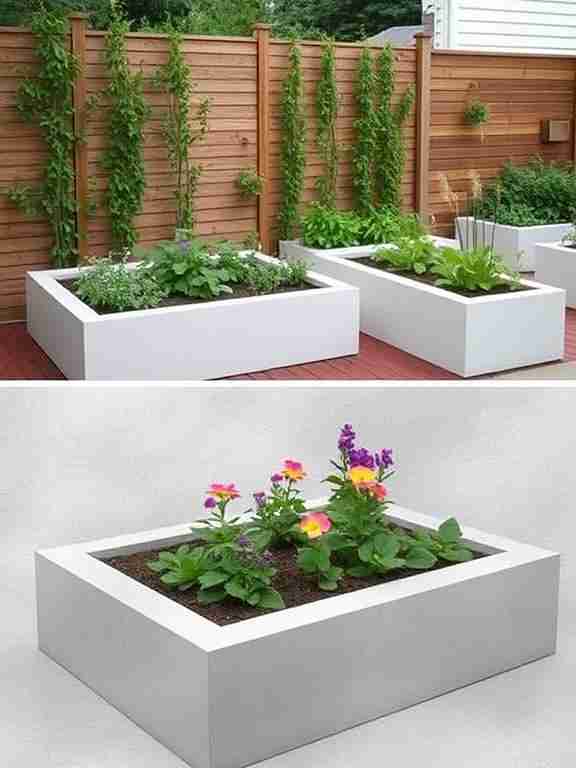
Source
If you prefer a more minimalist and contemporary aesthetic, concrete raised beds are the way to go. Concrete offers a sleek, clean look that contrasts beautifully with the organic forms of plants and flowers. This modern material works well with metal, wood, or even brick fences, creating a sophisticated atmosphere in your garden.
Concrete raised beds are highly durable and require minimal maintenance, making them a long-lasting addition to your garden. They are also customizable, allowing you to create various shapes and sizes. Whether you prefer the smooth, polished finish of poured concrete or the rustic charm of concrete blocks, these beds can be designed to fit any style.
The simplicity of concrete raised beds makes them a perfect choice for those who appreciate understated elegance. They provide a neutral backdrop for your flowers, allowing their colors and textures to shine. Concrete beds also have excellent drainage, ensuring that your plants grow healthy and strong.
10. Raised Beds with Built-in Bench Seating
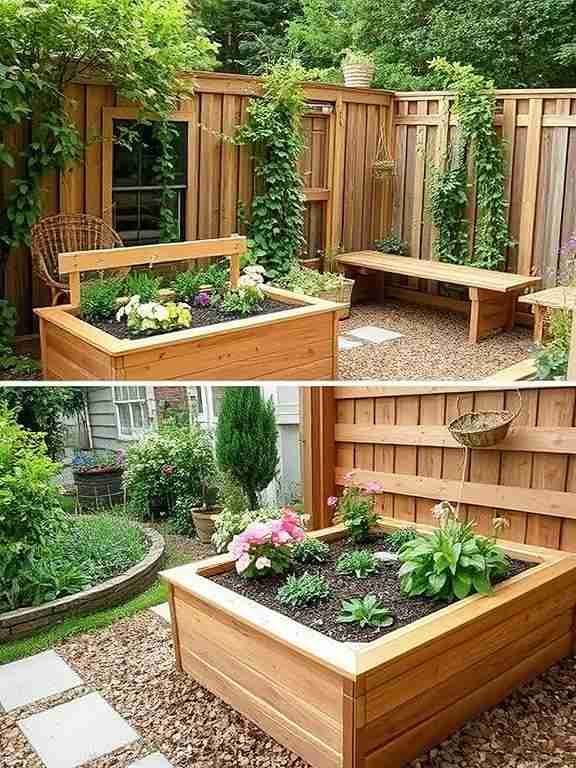
Source
For gardens that serve as a retreat, consider adding built-in bench seating to your raised flower beds. These multi-functional beds not only provide space for planting flowers but also create a cozy spot to sit and enjoy the beauty of your garden. Placing benches around your raised beds invites relaxation, making your garden feel like an extension of your living room.
You can design raised beds with benches that are seamlessly integrated into the structure, or add standalone benches along the edge of the garden. This design is perfect for creating a peaceful, comfortable space where you can unwind and take in your surroundings. The raised beds themselves can be planted with flowers that attract butterflies, birds, and bees, making the experience even more enchanting.
Built-in benches make it easy to care for your plants without having to kneel or bend over. They also add a charming and inviting feature to your garden, transforming it into a welcoming outdoor living area. Whether you’re hosting guests or simply enjoying some quiet time, these benches add both functionality and beauty to your garden.
11. Raised Flower Beds with Decorative Fencing
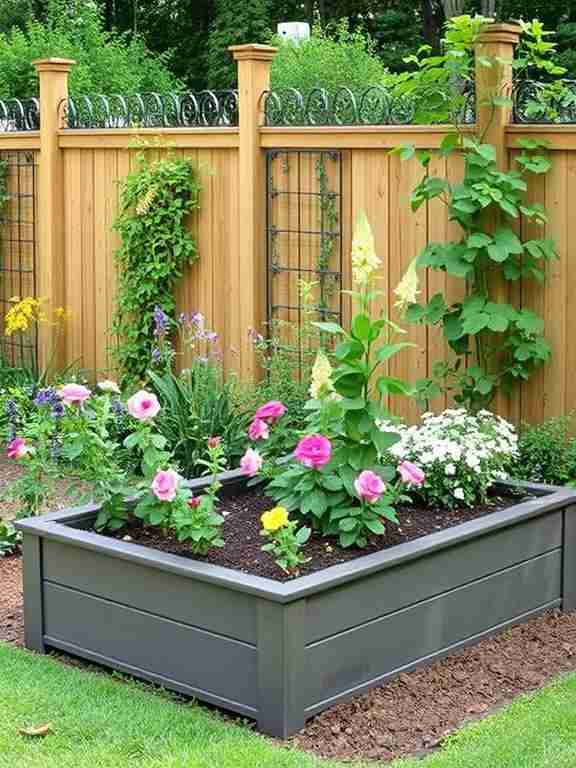
Source
Enhance the appearance of your raised flower beds by incorporating decorative fencing around the edges. Whether you opt for wrought iron, bamboo, or wood, decorative fencing adds an extra layer of style and sophistication to your garden. These fences not only define the boundaries of your raised beds but also add an element of vertical design that complements your fence.
Decorative fencing can be customized to fit your personal style, from intricate, ornamental designs to simpler, more rustic options. You can use it to create a more formal garden layout or add a whimsical touch to a cottage-style garden. The combination of the raised beds and decorative fencing creates a visually appealing garden that’s both functional and eye-catching.
Additionally, decorative fencing provides support for climbing plants and vines, allowing you to grow plants like roses, clematis, or jasmine. This not only adds height to your garden but also creates a lush, green environment that feels like an oasis.
12. Raised Beds for a Flower and Vegetable Combo
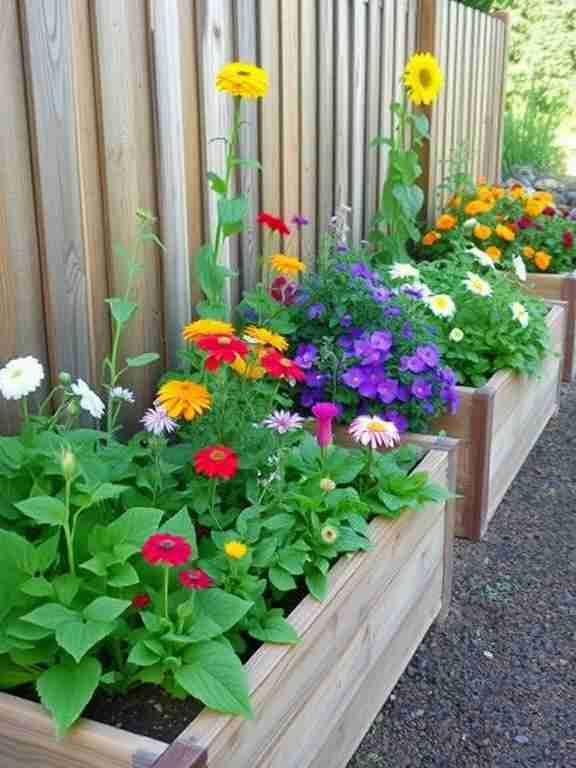
Source
Combine the beauty of flowers with the practicality of vegetables in your raised flower beds. By incorporating both flowers and vegetables in the same garden, you create a vibrant and productive space along your fence. Raised beds provide the perfect environment for a variety of plants, and you can customize the layout to suit your specific needs.
Mixing flowers with vegetables offers a number of benefits. The flowers help attract pollinators like bees and butterflies, which are essential for vegetable production. Plus, certain flowers, like marigolds and nasturtiums, can act as natural pest repellents, keeping your vegetables safe from harmful insects.
This combination allows you to grow a variety of plants, including tomatoes, lettuce, carrots, and sunflowers, all in the same space. The result is a colorful, thriving garden that provides both beauty and food. Raised beds help maximize space, making it easier to grow a diverse range of plants without sacrificing aesthetics.
13. Raised Beds with Built-in Irrigation

Source
If you’re looking for a low-maintenance way to keep your garden healthy, consider adding built-in irrigation to your raised flower beds. An irrigation system ensures your plants receive consistent moisture, which is especially important during hot summer months. Raised beds naturally drain well, but an irrigation system ensures that the plants get enough water without over-saturating the soil.
There are a variety of irrigation options available, including drip systems, soaker hoses, or even self-watering containers. This system works particularly well for larger raised flower beds along fences, where hand watering can become time-consuming. With a built-in irrigation system, you can save time and effort, allowing your plants to thrive with minimal intervention.
An irrigation system also helps conserve water by delivering moisture directly to the plant roots, reducing waste and ensuring efficient use of resources. With proper irrigation, your raised flower beds will stay lush and healthy all season long, even during periods of drought.
14. Raised Flower Beds with a Natural Stone Border
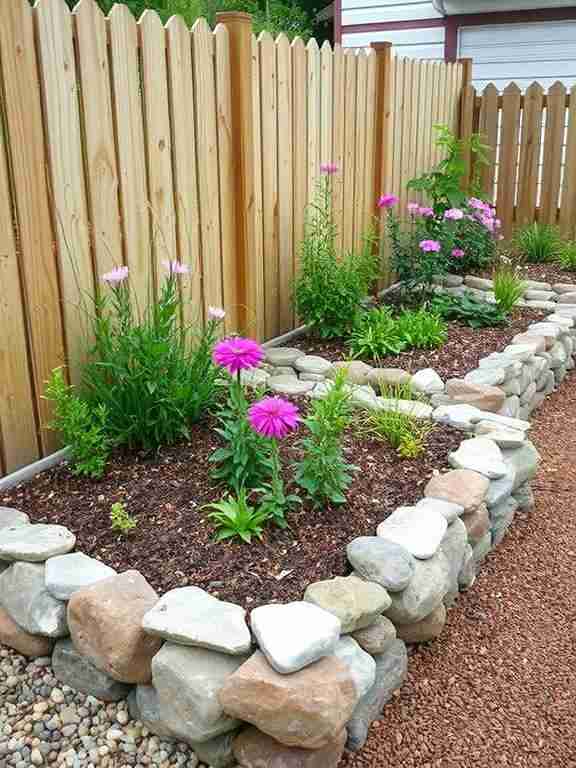
Source
Adding a natural stone border to your raised flower beds creates a beautiful, organic look that complements any type of fence. Whether you choose rough-hewn stones or polished, smooth pebbles, stone borders enhance the aesthetic appeal of your garden, providing texture and visual interest. This design is perfect for gardens with rustic or natural themes, especially when paired with wood or iron fences.
The stone border helps define the edges of the raised beds, giving them structure and preventing soil from spilling over. This is especially beneficial if you plan to fill the raised beds with a variety of plants. The stone also adds an earthy, timeless quality that works well in any outdoor setting. Additionally, the stones can help retain moisture in the soil, reducing water evaporation and providing a stable growing environment for your flowers.
Stone borders are durable and low-maintenance, making them a great choice for gardeners who want a long-lasting solution. They’re also versatile and can be arranged in a variety of ways, such as stacked or laid flat, depending on your preference. This design pairs beautifully with a range of garden styles, from traditional to contemporary, adding a touch of elegance and natural beauty to your raised beds.
15. Low-Maintenance Raised Flower Beds with Drought-Tolerant Plants
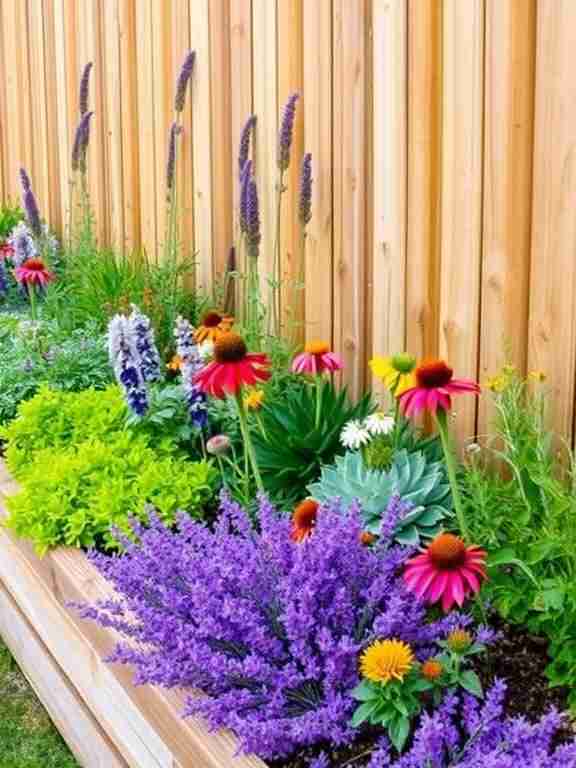
Source
For those in regions that experience long dry spells, creating low-maintenance raised flower beds filled with drought-tolerant plants is an excellent way to ensure your garden thrives without requiring constant watering. Plants like lavender, succulents, and coneflowers not only withstand dry conditions but also add stunning texture and color to your garden along the fence.
Drought-tolerant plants are perfect for raised beds because they don’t require excessive water, which makes them a sustainable choice for gardeners looking to reduce their water usage. Raised beds also allow you to create the ideal growing environment for these types of plants by ensuring good drainage and controlling the soil conditions. This is especially beneficial if you live in an area with heavy clay soil or poor drainage.
This design is both practical and aesthetically pleasing. Drought-tolerant plants often have striking foliage, vibrant flowers, and unique textures that create a visually appealing landscape. Plus, by choosing native or hardy plants, you’ll attract beneficial pollinators such as bees and butterflies, helping to support local ecosystems. With proper planning and the right plant selection, these raised flower beds can be both a beautiful and eco-friendly addition to your garden.
16. Raised Beds for Pollinator-Friendly Gardens

Source
Creating raised flower beds designed specifically to attract pollinators is an inspiring and environmentally-friendly way to enhance your garden. Pollinator-friendly gardens provide a habitat for bees, butterflies, birds, and other beneficial insects that play an essential role in the health of your garden and the environment. By choosing the right flowers, you can create a haven for these creatures right along your fence.
To create a pollinator-friendly garden in your raised beds, choose flowers that are known to attract bees and butterflies. Plants like sunflowers, daisies, and milkweed are excellent choices. In addition to providing nectar, some plants offer pollen or shelter, making them ideal for pollinators to thrive. Raised beds are the perfect way to organize these plants and ensure they have the right conditions to grow.
Incorporating pollinator-friendly flowers not only helps the local ecosystem but also adds vibrant colors and textures to your garden. A well-planned pollinator garden is a win-win: it enhances the beauty of your outdoor space while supporting wildlife and biodiversity. Whether you’re growing flowers, herbs, or vegetables, including plants that support pollinators will make your garden both functional and eco-conscious.
17. Upcycled Fence Wood Raised Beds for Eco-Friendly Gardening

Source
If you have old fence wood lying around, why not repurpose it into raised flower beds? Upcycling wood from your fence is an environmentally-friendly way to reduce waste and create functional garden beds that add rustic charm to your space. These upcycled beds are perfect for anyone looking to embrace a more sustainable lifestyle while giving their garden a unique, personalized touch.
Upcycled fence wood has a weathered look that perfectly complements gardens with a vintage or farmhouse vibe. The natural patina of the wood adds character and warmth, making it ideal for rustic or country-style gardens. You can use the wood to create simple rectangular beds, or get creative by building more intricate designs. The material is easy to work with and can be stained, painted, or left in its natural state depending on your aesthetic.
Not only do these upcycled raised beds reduce waste, but they also offer a cost-effective solution for creating a beautiful garden. They’re perfect for growing flowers, herbs, or vegetables, and can be arranged along your fence to maximize space. With minimal cost and effort, you can create a stylish and sustainable garden that benefits both you and the planet.
18. Raised Flower Beds with Glass Blocks for a Modern Edge
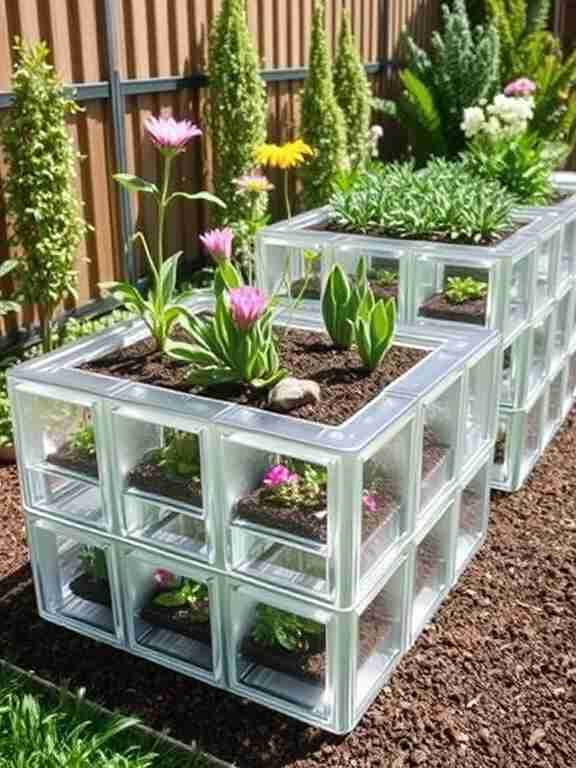
Source
For a truly unique and modern garden design, consider using glass blocks to create raised flower beds. Glass blocks are an excellent choice for those seeking a contemporary, sleek aesthetic that still allows light to filter through and add sparkle to your garden. These translucent blocks create a beautiful, almost ethereal effect as they catch the sunlight, making them perfect for modern or minimalist gardens.
Glass blocks are durable, weather-resistant, and easy to work with. They can be arranged in rows or stacked to form raised beds of various heights. Their transparent quality creates an open, airy feel, which works well in gardens with contemporary metal or wooden fences. The blocks also allow plants to be viewed from both the inside and outside of the garden, providing a striking visual effect.
While glass blocks may not be the first material that comes to mind when thinking of raised beds, they offer a unique combination of style and function. They help to retain moisture in the soil, reducing the need for frequent watering, and they can be filled with a variety of plants, from flowers to herbs and succulents. This modern design choice makes a bold statement and is sure to be a conversation starter.
19. Raised Beds for a Cottage Garden Look
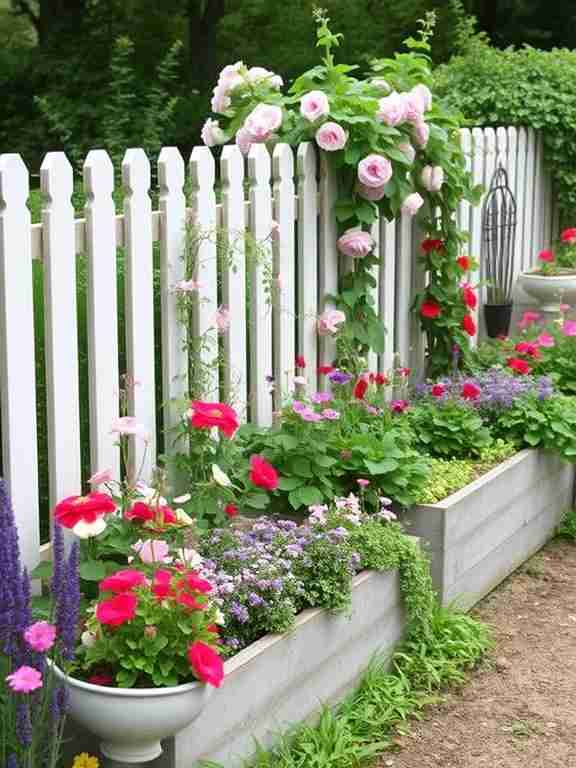
Source
If you love the charming, whimsical feel of a cottage garden, raised flower beds are the perfect way to create this look along your fence. A cottage garden features an array of colorful flowers, climbing vines, and aromatic herbs that give the space an inviting, nostalgic atmosphere. Raised beds make it easy to create this lush, flower-filled garden while also keeping your plants organized and contained.
To achieve a cottage garden look, fill your raised beds with a mix of traditional flowers such as roses, lavender, peonies, and hollyhocks. Add climbing vines like sweet peas or wisteria to drape over your fence, creating a romantic, old-fashioned feel. Raised beds help define different areas of the garden, allowing you to separate flowers, herbs, and vegetables, while still maintaining a free-flowing, informal layout.
This style of garden works wonderfully with wood or picket fences, as these materials enhance the rustic charm of a cottage garden. With careful planning and a mix of colorful flowers, you can create a garden that looks like it came straight out of a storybook, all along your fence.
20. Raised Flower Beds with Built-in Lighting
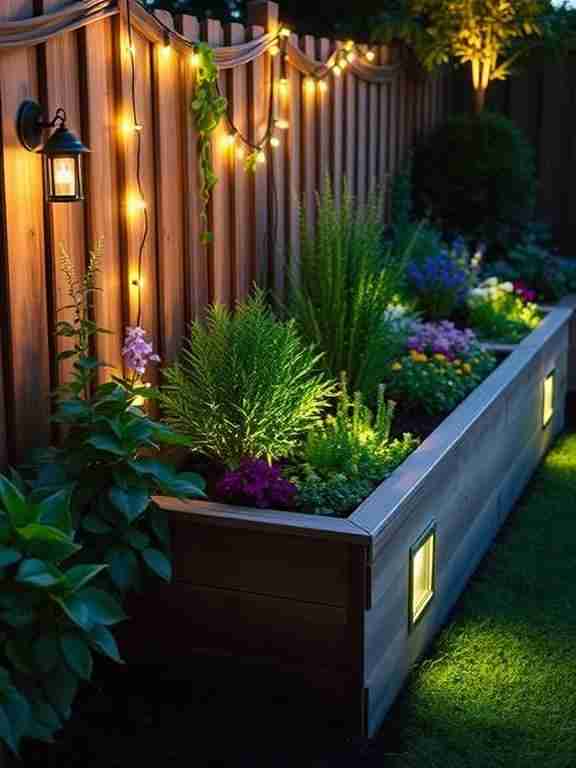
Source
Enhancing your raised flower beds with built-in lighting is a fantastic way to enjoy your garden even after the sun sets. Outdoor lighting can transform your garden into a magical space, casting soft, warm glows that highlight your plants and create a peaceful, inviting atmosphere. Whether you opt for subtle LED lights or decorative lantern-style fixtures, lighting adds both beauty and functionality to your raised beds.
There are many ways to incorporate lighting into your raised flower beds. You can install lights along the edges of the bed, or embed them within the structure of the bed itself. Lights placed under the plants can create a soft, glowing effect that highlights the foliage and blooms. String lights or fairy lights draped over the fence can add an extra touch of whimsy, especially in a garden designed for relaxation and entertainment.
This addition is perfect for evening gatherings or creating a calm, serene environment for you to unwind. Lighting not only improves visibility but also sets the mood for cozy, outdoor evenings. With the right lighting, your raised flower beds will shine day and night.
21. Raised Beds with Lattice Work for Climbing Plants
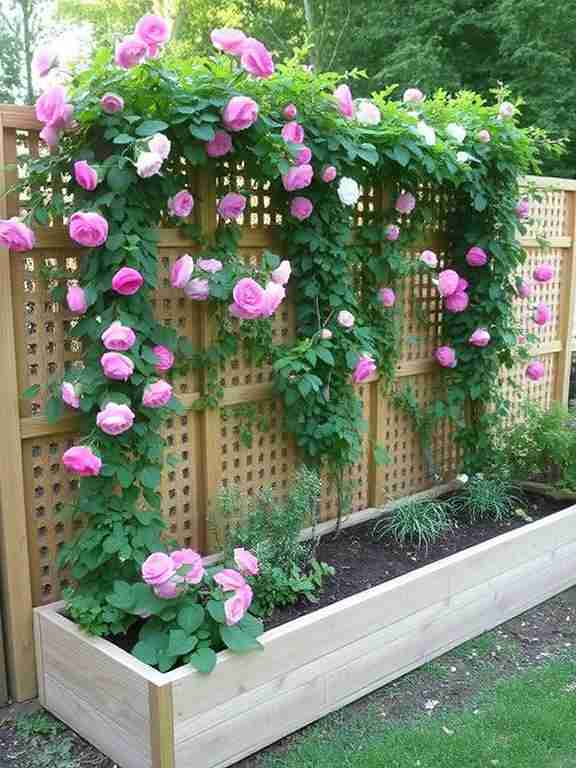
Source
If you love the idea of growing climbing plants, adding lattice work to your raised flower beds is the perfect solution. Lattice allows climbing flowers like roses, clematis, and ivy to grow upward, creating a stunning vertical garden. The trellis effect also adds a layer of visual interest, as your plants weave and climb over the structure, enhancing the overall beauty of the space.
Lattice work can be easily attached to the sides of your raised beds or installed along your fence, providing ample support for climbing plants. This design is perfect for gardeners who want to add height and dimension to their garden while also maximizing space. The flowers that climb over the lattice create a lush, romantic atmosphere, making your garden a beautiful place to spend time.
In addition to providing support for climbing plants, lattice work can also create additional privacy or shade in your garden. It offers an elegant, decorative element while helping your plants grow and thrive. The combination of raised beds and lattice work adds structure, elegance, and functionality to your garden along the fence.
22. Concrete Block Raised Beds for a Contemporary Style

Source
For a sleek, modern look, consider using concrete blocks to build your raised flower beds. These sturdy blocks create clean lines and geometric shapes that add a contemporary flair to your garden. Concrete is durable and weather-resistant, making it a long-lasting material for raised beds, and it works especially well with modern fences made from metal or wood.
Concrete block raised beds are versatile and can be designed in various configurations. You can stack the blocks to create taller beds, or lay them flat for a more horizontal look. The simplicity of concrete allows the focus to remain on your plants, giving them a clean, minimalist backdrop that lets their colors and textures shine.
Concrete raised beds are easy to maintain and can handle a variety of plants, from flowers to vegetables. The heavy-duty material ensures your plants are protected from wind or erosion, and the blocks help retain moisture, making it easier to manage watering. This design is perfect for modern gardens where function and style go hand in hand.
23. Raised Flower Beds with Decorative Edging
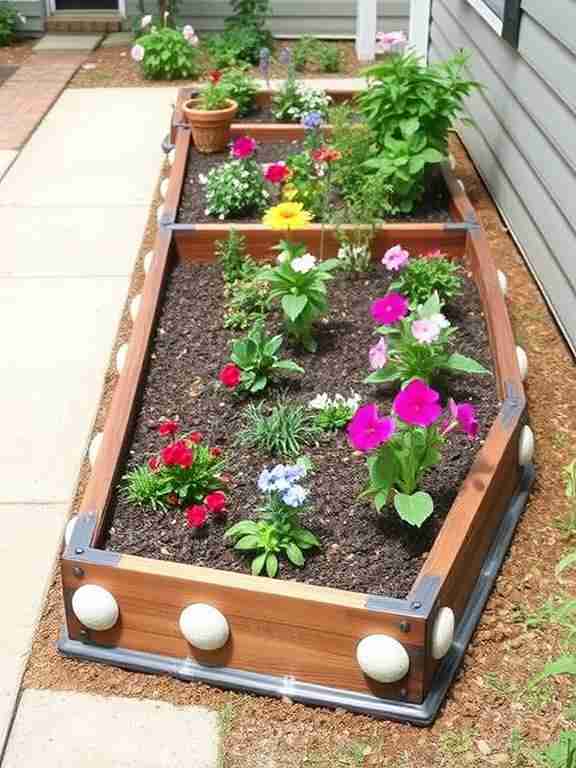
Source
Adding decorative edging to your raised flower beds is an easy way to elevate their appearance and create a polished, cohesive look. Whether you choose metal, wood, or stone edging, these decorative elements can frame your beds beautifully and provide a finished appearance that ties your garden together. Edging can also help contain soil and mulch, preventing it from spilling onto surrounding areas.
Decorative edging adds a personal touch to your garden and can be customized to match the overall style of your outdoor space. Metal edging, for example, adds a sleek, industrial look, while wooden or stone edging creates a more rustic or natural appearance. The right edging can complement your fence and other garden features, bringing everything together in a harmonious design.
In addition to its aesthetic appeal, edging helps keep weeds at bay and can protect your plants from lawnmowers or garden tools. It’s a functional addition that adds beauty and order to your raised flower beds.
Conclusion: A Garden That Reflects You
Designing raised flower beds along your fence offers countless possibilities for creating a beautiful, personalized garden space. Whether you prefer rustic, modern, or eco-friendly solutions, there’s a design that can help you achieve your dream garden. By considering materials, plant choices, and creative touches like lighting or lattice work, you can transform your outdoor space into a vibrant oasis.
The beauty of raised flower beds is that they provide both functionality and aesthetic appeal. They make gardening more accessible, help define your space, and offer opportunities to incorporate your personal style. With the right materials and designs, your raised flower beds will be the perfect backdrop for a flourishing garden that’s both beautiful and easy to maintain.
